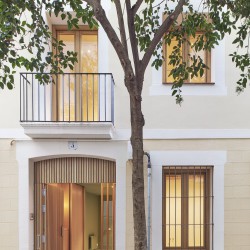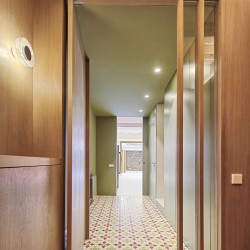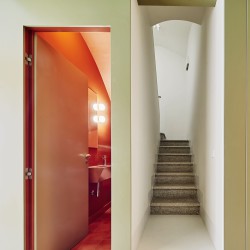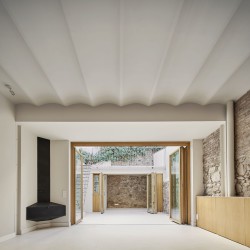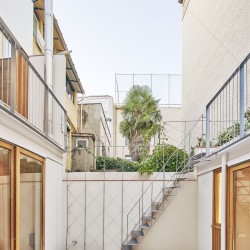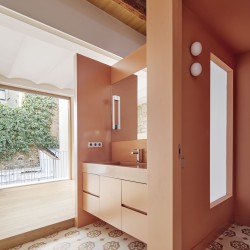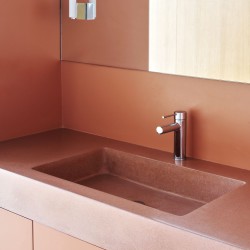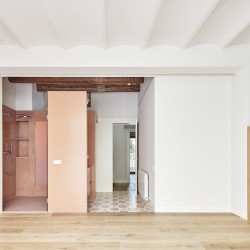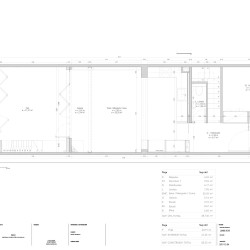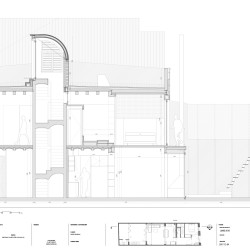Septiembre Arquitectura . photos: © José Hevia
We are located in the old town of Sarria, Barcelona, in a house between party walls, full of history, Miquel, an 80-year-old man lives alone after years of living with his wife’s entire family. The family home was acquired in the late 1960s and grew through expansion at the same rate as the family. Already lacking life, Miquel decides to sell it. The new buyers are a family from the area, who value the qualities of a quiet and familiar neighbourhood and the original construction characteristics of the property.
MIQ, short for Miquel, is a comprehensive rehabilitation of a single-family house between party walls. The original wealth of the house is more than remarkable, the reddish, tile and green tones predominate, with hydraulic floors, brick and stone walls with Catalan volta ceilings, upon reaching the back patio, a wild nature surrounds you and reveals the small post-study. This constructive wealth is the source of inspiration for the project.
September Architecture feeds on this original wealth and adapts it to new needs and uses. Enhancing the superposition of styles, which allows the history, the spirit of the home and some of its construction details to be preserved and transformed into a new reality. The proposal is a balance between the new needs of housing and the recovery of existing inheritance. Something like elevating the wear and tear of the old home to become a historical asset.
The result proposes a house with three bedrooms, a living-dining room with kitchen and a study at the rear of the backyard. The original staircase is respected, but the exit to the roof is remade, executing a roof formed by a large isolated Catalan double turn and an opening facing south-west. In this way, the project turns the staircase into a light well in winter and a ventilation chimney in summer, where the adjustable slats control the solar incidence. The main room is endowed with a defragmented bathroom with walls that do not reach the ceiling, thus allowing cross ventilation through the staircase and the entrance of light at both ends of the room. Finally, a large sliding door closes the suite and gives access to a balcony that faces the backyard.
On the ground floor is the living-dining room and open kitchen, to enhance the spaciousness of the spaces and the relationship between interior and exterior, this room is the only one next to the staircase that is dressed in white, the interior flooring and exteriors merge into one and the balcony doors to the patio and study fold out, allowing the interior and exterior to be unified in a single space.
The image of the house from the street is a picturesque two-storey facade, covered in pastel shades and wood, which coexists peacefully with its adjacent buildings. On the contrary, the rear façade is made up of large openings, a white corrugated sheet skin that contrasts with the woodwork and exposed elements of the installations. Therefore, a contrast is created that reveals the transforming will of design.
The main entrance to the house is through an oak-lined hall, the original hydraulic floors are recovered and, if necessary, are reissued with the Huguet factory in Mallorca, which manages to imitate the original designs. The walls take on the colour tones of the hydraulic parts, green in the distributor, deep reddish in the courtesy toilet and terracotta salmon for the bathroom of the suite. The tailored design of the sinks with the same materials and colours is studied in-depth, as well as the large hydraulic parts that line the walls of the shower. The light invades all the rooms, including the general bathroom on the first floor, which is located in an interior area and that through a Spectralight tube, captures natural light up to the skylight above the bathtub.
The rest of the spaces recover the original ceilings with wooden and metal beams, showing the construction phases of the building. Thus, the rooms are covered with parquet floors, while the original stone and brick walls dress the living room, the head of the suite, the patio and the study. The exterior metal staircase, designed in such a way that it acquires great lightness, ascends to the walkable roof of the studio, thus taking advantage of all the exterior spaces.
The design of the house aims to return the wild character of the vegetation, for this a planter and a metal structure are created that arise from the railing of the external staircase and that will allow the recovery of the existing vegetation.
_
Project:
Housing Renovation and Interior Design
Client:
Private
Location:
Sarria, Barcelona
Date of delivery:
2019
Size:
213 m2
Design and Creative Team: Septiembre Arquitectura Sara Baldasano
Damian Figueras Maddi Urdampilleta
Technical team andoperation:
Raúl Heras
Ester Martínez Estructuras Constructora Varela
Photographer
José Hevia
Nos situamos en pleno casco antiguo de Sarriá, Barcelona, en una casa entre medianeras, llena de historia, Miquel un señor de 80 años vive solo tras años de convivencia con toda la familia de su mujer. La casa familiar fue adquirida a finales de los ’60 y creció mediante ampliaciones al ritmo que lo hacía la familia. Falta ya de vida, Miquel decide venderla. Los nuevos compradores son una familia de la zona, que valoran las cualidades de un barrio tranquilo y familiar y características constructivas originales del inmueble. MIQ, abreviativo de Miquel, es una rehabilitación integral de una casa unifamiliar entre medianeras. La riqueza original de la casa es más que destacable, predominan los tonos rojizos, tejas y verdes, con suelos hidráulicos, paredes de ladrillo y piedra con techos de volta catalana, al llegar al patio posterior, una naturaleza salvaje te rodea y te descubre el pequeño estudio posterior. Esta riqueza constructiva, es la fuente de inspiración para el proyecto. Septiembre Arquitectura se alimenta de esta riqueza original y la adapta a las nuevas necesidades y usos. Potenciando la superposición de estilos, que permite conservar la historia, el espíritu de la vivienda y alguno de sus detalles constructivos y transformarla en una nueva realidad. El trabajo es un ir y venir entre las nuevas necesidades de la vivienda y la recuperación de la herencia existente. Algo así como elevar el desgaste del antiguo hogar hasta convertirlo en un activo histórico. El resultado propone una casa con tres habitaciones, un salón-comedor con cocina y un estudio en la parte trasera del patio posterior. Se respeta la escalera original, pero se rehace la salida al terrado, ejecutando una cubierta formada por una gran doble vuelta catalana aislada y una abertura orientada a sur-oeste. De esta forma el proyecto convierte la escalera en un pozo de luz en invierno y una chimenea de ventilación en verano, donde las lamas orientables controlan la incidencia solar. La habitación principal está dotada de un baño desfragmentado con paredes que no llegan al techo, permitiendo así la ventilación cruzada a través de la escalera y la entrada de luz por ambos extremos de la habitación. Finalmente, una gran corredera cierra la suite y da acceso a un balcón que mira hacia el patio posterior. En la planta baja se sitúa el salón-comedor y la cocina abierta, para potenciar la amplitud de los espacios y la relación entre el interior y el exterior, esta estancia es la única junto a la escalera que se visten de blanco, los pavimentos interiores y exteriores se funden en uno solo y las balconeras de salida al patio y al estudio, se pliegan permitiendo unificar interior y exterior en un solo espacio. La imagen de la casa desde la calle, es una pintoresca fachada de dos plantas, cubierta de tonos pastel y madera, que convive apaciblemente con sus construcciones adyacentes. Por el contrario, la fachada posterior está formada por grandes aberturas, una piel de chapa grecada blanca que contrasta con la carpintería de madera y los elementos de instalaciones vistos. Se crea, por tanto, una contraposición que pone en manifiesto la voluntad transformadora del diseño. La entrada principal a la vivienda es mediante un recibidor forrado de madera de roble, los suelos hidráulicos originales se recuperan y en caso necesario, se reeditan con la fábrica Huguet en Mallorca, que consigue imitar los diseños originales. Las paredes adquieren los tonos de color de las piezas hidráulicas, verde en el distribuidor, rojizo intenso en el aseo de cortesía y salmón terracota para el baño de la suite. Se profundiza en el diseño a medida de los lavamanos con los mismos materiales y colores, así como las grandes piezas hidráulicas que forran las paredes de la ducha. La luz invade todas las estancias, incluyendo el baño general de la planta primera, que está ubicado en una zona interior y que a través de un tubo Spectralight, se capta la luz natural hasta el lucernario situado encima de la bañera. El resto de espacios recupera los techos originales con bigas de madera y metálicas, manifestando las fases constructivas del edificio. Así, las habitaciones se cubren con suelos de parquet, mientras que las paredes de piedra y ladrillo originales visten el salón, el cabezal de la suite, el patio y el estudio. La escalera metálica exterior, diseñada de forma que adquiere gran ligereza, asciende hasta la cubierta transitable del estudio, aprovechando así todos los espacios exteriores. El diseño de la casa pretende devolver el carácter salvaje de la vegetación, para ello se crea una jardinera y una estructura metálica que nace de la barandilla de la escalera exterior y que permitirá la recuperación de la vegetación existente.


